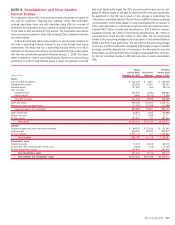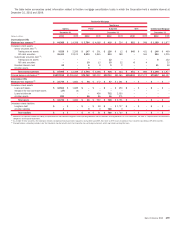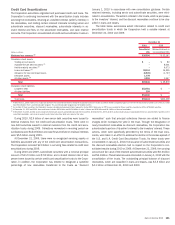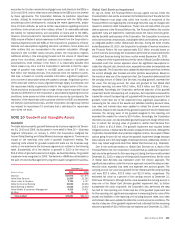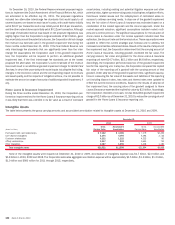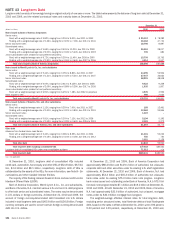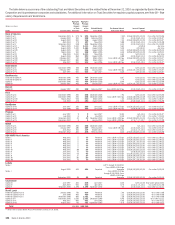Bank of America 2010 Annual Report Download - page 189
Download and view the complete annual report
Please find page 189 of the 2010 Bank of America annual report below. You can navigate through the pages in the report by either clicking on the pages listed below, or by using the keyword search tool below to find specific information within the annual report.Leveraged Lease Trusts
The Corporation’s net investment in consolidated leveraged lease trusts
totaled $5.2 billion and $5.6 billion at December 31, 2010 and 2009. The
trusts hold long-lived equipment such as rail cars, power generation and
distribution equipment, and commercial aircraft. The Corporation structures
the trusts and holds a significant residual interest. The net investment
represents the Corporation’s maximum loss exposure to the trusts in the
unlikely event that the leveraged lease investments become worthless. Debt
issued by the leveraged lease trusts is nonrecourse to the Corporation. The
Corporation has no liquidity exposure to these leveraged lease trusts.
Asset Acquisition Conduits
The Corporation currently administers two asset acquisition conduits which
acquire assets on behalf of the Corporation or its customers. The Corporation
liquidated a third conduit during 2010. Liquidation of the conduit did not
impact the Corporation’s consolidated results of operations. These conduits
had total assets of $640 million and $2.2 billion at December 31, 2010 and
2009. One of the conduits acquires assets at the request of customers who
wish to benefit from the economic returns of the specified assets on a
leveraged basis, which consist principally of liquid exchange-traded equity
securities. The second conduit holds subordinate AFS debt securities for the
Corporation’s benefit. The conduits obtain funding by issuing commercial
paper and subordinate certificates to third-party investors. Repayment of the
commercial paper and certificates is assured by total return swaps between
the Corporation and the conduits. When a conduit acquires assets for the
benefit of the Corporation’s customers, the Corporation enters into
back-to-back total return swaps with the conduit and the customer such that
the economic returns of the assets are passed through to the customer. The
Corporation’s exposure to the counterparty credit risk of its customers is
mitigated by the ability to liquidate an asset held in the conduit if the customer
defaults on its obligation. The Corporation receives fees for serving as
commercial paper placement agent and for providing administrative services
to the conduits. At December 31, 2010 and 2009, the Corporation did not
hold any commercial paper issued by the asset acquisition conduits other
than incidentally and in its role as a commercial paper dealer.
Real Estate Vehicles
The Corporation held investments in unconsolidated real estate vehicles of
$5.4 billion and $4.8 billion at December 31, 2010 and 2009, which con-
sisted of limited partnership investments in unconsolidated limited partner-
ships that finance the construction and rehabilitation of affordable rental
housing. An unrelated third party is typically the general partner and has
control over the significant activities of the partnership. The Corporation earns
a return primarily through the receipt of tax credits allocated to the affordable
housing projects. The Corporation’s risk of loss is mitigated by policies
requiring that the project qualify for the expected tax credits prior to making
its investment. The Corporation may from time to time be asked to invest
additional amounts to support a troubled project. Such additional invest-
ments have not been and are not expected to be significant.
Other Transactions
In 2010 and prior years, the Corporation transferred pools of securities to
certain independent third parties and provided financing for approximately
75 percent of the purchase price under asset-backed financing arrangements.
At December 31, 2010 and 2009, the Corporation’s maximum loss exposure
under these financing arrangements was $6.5 billion and $6.8 billion, sub-
stantially all of which was classified as loans on the Corporation’s Consol-
idated Balance Sheet. All principal and interest payments have been received
when due in accordance with their contractual terms. These arrangements are
not included in the table on page 186 because the purchasers are not VIEs.
NOTE 9 Representations and Warranties
Obligations and Corporate Guarantees
Background
The Corporation securitizes first-lien residential mortgage loans, generally in the
form of MBS guaranteed by GSEs or GNMA in the case of FHA-insured and VA-
guaranteed mortgage loans. In addition, in prior years, legacy companies and
certain subsidiaries have sold pools of first-lien residential mortgage loans,
home equity loans and other second-lien loans as private-label securitizations
or in the form of whole loans. In connection with these transactions, the
Corporation or certain subsidiaries or legacy companies made various repre-
sentations and warranties. These representations and warranties, as governed
by the agreements, related to, among other things, the ownership of the loan,
the validity of the lien securing the loan, the absence of delinquent taxes or liens
against the property securing the loan, the process used to select the loan for
inclusion in a transaction, the loan’s compliance with any applicable loan
criteria, including underwriting standards, and the loan’s compliance with
applicable federal, state and local laws. Breaches of these representations
and warranties may result in a requirement to repurchase mortgage loans, or to
otherwise make whole or provide other remedy to a whole-loan buyer or
securitization trust. In such cases, the Corporation would be exposed to any
subsequent credit loss on the mortgage loans. The Corporation’s credit loss
would be reduced by any recourse to sellers of loans (i.e., correspondents) for
representations and warranties previously provided. When a loan was origi-
nated by a third-party correspondent, the Corporation typically has the right to
seek a recovery of related repurchase losses from the correspondent origina-
tor. At December 31, 2010, loans purchased from correspondents comprised
approximately 25 percent of loans underlying outstanding repurchase de-
mands. During 2010, the Corporation experienced a decrease in recoveries
from correspondents, however, the actual recovery rate may vary from period to
period based upon the underlying mix of correspondents (e.g., active, inactive,
out-of-business originators) from which recoveries are sought.
Subject to the requirements and limitations of the applicable agreements,
these representations and warranties can be enforced by the securitization
trustee or the whole-loan buyer as governed by the applicable agreement or, in
certain first-lien and home equity securitizations where monolines have
insured all or some of the related bonds issued, by the monoline insurer
at any time over the life of the loan. Importantly, in the case of non-GSE loans,
the contractual liability to repurchase arises if there is a breach of the
representations and warranties that materially and adversely affects the
interest of all investors, or if there is a breach of other standards established
by the terms of the related sale agreement. The Corporation believes that the
longer a loan performs prior to default, the less likely it is that an alleged
underwriting breach of representations and warranties had a material impact
on the loan’s performance. Historically, most demands for repurchase have
occurred within the first few years after origination, generally after a loan has
defaulted. However, in recent periods the time horizon has lengthened due to
increased repurchase request activity across all vintages.
The Corporation’s current operations are structured to limit the risk of
repurchase and accompanying credit exposure by seeking to ensure consis-
tent production of mortgages in accordance with its underwriting procedures
and by servicing those mortgages consistent with its contractual obligations.
In addition, certain securitizations include guarantees written to protect
certain purchasers of the loans from credit losses up to a specified amount.
The fair value of the probable losses to be absorbed under the representa-
tions and warranties obligations and the guarantees is recorded as an
accrued liability when the loans are sold. The liability for probable losses is
updated by accruing a representations and warranties provision in mortgage
banking income throughout the life of the loan as necessary when additional
relevant information becomes available. The methodology used to estimate
Bank of America 2010 187


